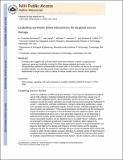| dc.contributor.author | Reinhardt, H. Christian | |
| dc.contributor.author | Jiang, Hai | |
| dc.contributor.author | Hemann, Michael | |
| dc.contributor.author | Yaffe, Michael B | |
| dc.date.accessioned | 2012-10-04T19:49:54Z | |
| dc.date.available | 2012-10-04T19:49:54Z | |
| dc.date.issued | 2009-10 | |
| dc.date.submitted | 2009-07 | |
| dc.identifier.issn | 1538-4101 | |
| dc.identifier.uri | http://hdl.handle.net/1721.1/73619 | |
| dc.description | March 15, 2011 | en_US |
| dc.description.abstract | Emerging data suggests that synthetic lethal interactions between mutated oncogenes/tumor suppressor genes and molecules involved in DNA damage signaling and repair can be therapeutically exploited to preferentially kill tumor cells. In this review, we discuss the concept of synthetic lethality, and describe several recent examples in which this concept was successfully implemented to target tumor cells in culture, in mouse models, and in human cancer patients. | en_US |
| dc.description.sponsorship | National Institutes of Health (U.S.) (Grant GM68762) | en_US |
| dc.description.sponsorship | National Institutes of Health (U.S.) (Grant CA112967) | en_US |
| dc.description.sponsorship | National Institutes of Health (U.S.) (Grant ES015339) | en_US |
| dc.description.sponsorship | National Cancer Institute (U.S.). Integrative Cancer Biology Program (Grant U54-CA112967-03) | en_US |
| dc.description.sponsorship | German Research Foundation (RE2246/1-1) | en_US |
| dc.description.sponsorship | David H. Koch Cancer Research Fund | en_US |
| dc.description.sponsorship | German Kidney Foundation | en_US |
| dc.language.iso | en_US | |
| dc.publisher | Landes Bioscience | en_US |
| dc.relation.isversionof | http://dx.doi.org/10.4161/cc.8.19.9626 | en_US |
| dc.rights | Creative Commons Attribution-Noncommercial-Share Alike 3.0 | en_US |
| dc.rights.uri | http://creativecommons.org/licenses/by-nc-sa/3.0/ | en_US |
| dc.source | PMC | en_US |
| dc.title | Exploiting synthetic lethal interactions for targeted cancer therapy | en_US |
| dc.type | Article | en_US |
| dc.identifier.citation | Reinhardt, H. Christian et al. “Exploiting Synthetic Lethal Interactions for Targeted Cancer Therapy.” Cell Cycle 8.19 (2009): 3112–3119. | en_US |
| dc.contributor.department | Massachusetts Institute of Technology. Department of Biological Engineering | en_US |
| dc.contributor.department | Massachusetts Institute of Technology. Department of Biology | en_US |
| dc.contributor.department | Koch Institute for Integrative Cancer Research at MIT | en_US |
| dc.contributor.mitauthor | Jiang, Hai | |
| dc.contributor.mitauthor | Hemann, Michael | |
| dc.contributor.mitauthor | Yaffe, Michael B. | |
| dc.contributor.mitauthor | Reinhardt, H. Christian | |
| dc.relation.journal | Cell Cycle | en_US |
| dc.eprint.version | Author's final manuscript | en_US |
| dc.type.uri | http://purl.org/eprint/type/JournalArticle | en_US |
| eprint.status | http://purl.org/eprint/status/PeerReviewed | en_US |
| dspace.orderedauthors | Reinhardt, H. Christian; Jiang, Hai; Hemann, Michael; Yaffe, Michael B. | en |
| dc.identifier.orcid | https://orcid.org/0000-0002-9547-3251 | |
| mit.license | OPEN_ACCESS_POLICY | en_US |
| mit.metadata.status | Complete | |
